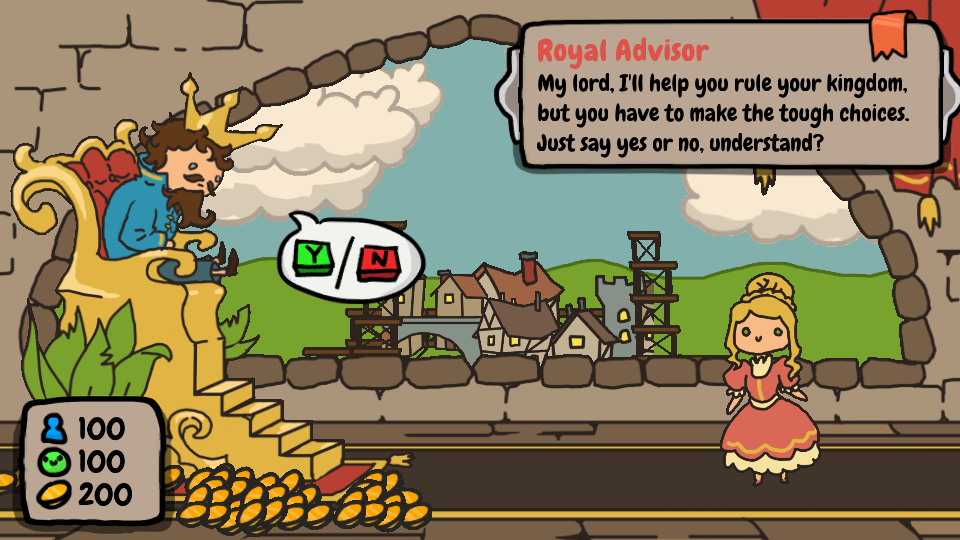Popular Games
View AllWatch Gameplay
What is Sort the Court
Sort the Court is a bite-size kingdom management game where you rule by answering petitions with simple Yes/No choices. Each day a parade of citizens, creatures, and oddballs asks for help, tribute, favors, or risky experiments, and your replies reshape the city’s people, happiness, and treasury in real time. Because each scene is short and readable, Sort the Court invites quick sessions that slowly snowball into long-term narratives with surprising payoffs. The project began as a 72-hour Ludum Dare 34 jam entry before expanding into a polished browser and downloadable build for HTML5, Windows, and Linux. That two-button premise—grow your realm using only Y/N—captures the jam’s themes of “Growing” and “Two Buttons” while staying friendly to newcomers and speed-readers alike. Released in December 2015 and created by developer Graeme Borland with art by Amy Gerardy and music by Bogdan Rybak, Sort the Court embraces charm over complexity while still rewarding planning and pattern recognition. ([graemeborland.com][1])
Core Features of Sort the Court
- Answer with confidence: the entire interface revolves around Y for Yes and N for No, letting you focus on judgment instead of UI
- Three living gauges—People, Happiness, and Gold—move after every decree, so Sort the Court turns micro decisions into macro outcomes you can feel instantly
- Evolving capital: as totals rise, you’ll unlock markets, guilds, festivals, and visiting dignitaries who introduce new opportunities and risks
- Memorable cast: wizards, devils, jesters, scientists, and sentient chests arrive with recurring quest lines that react to your history with them
- Multiple arcs and endings: stabilize the realm, court alliances, and ultimately qualify for the Council of Crowns while still being free to continue play afterwards
- Short days, big momentum: a single session lasts minutes, but compounding effects encourage “one more day” loops that stretch into satisfying runs
- Lightweight performance: Sort the Court runs in a browser and on modest hardware, so anyone can jump in without setup; the simplicity hides surprising depth. ([sort-the-court.fandom.com][2])
How to Play Sort the Court
- Begin your reign: greet petitioners, read their pitch, then press Y or N—there’s no cursor-hunting, just immediate choices and immediate feedback
- Track the meters: if People or Happiness fall too low, growth slows and events can turn harsher, so steady gains beat boom-and-bust spikes
- Build a base: early in Sort the Court, favor low-variance income like farms, markets, or safe trades to ensure daily gold trickles in
- Respect morale: small Happiness boosts often pay back via population growth and tax scaling, keeping your economy resilient through bad rolls
- Time the gambles: accept high-risk magic or mysterious deals only when a healthy treasury and mood can absorb a miss
- Advance the narrative: resolve regional disputes, nurture recurring NPC chains, and field envoys to move the realm toward the Council of Crowns milestone. ([sort-the-court.fandom.com][2])
Resource Management in Sort the Court
- People: more citizens unlock content and taxes, but also magnify the pain of disasters—protect them with steady services and prudent defense
- Happiness: the growth engine; when spirits rise, newcomers arrive, tax yields improve, and forgiveness for small mistakes increases
- Gold: fuel for everything—buy shops, fund festivals, or bankroll research that returns dividends over many days in Sort the Court
- Synergy first: raise Happiness to attract population, then invest Gold in ventures that monetize that bigger, happier city
- Buffers matter: keep a safety cushion in all three tracks so a streak of bad events can’t trigger a death spiral
- Transparent feedback: every decree shifts meters immediately, helping you learn which patterns your realm prefers and which to avoid next time
Winning Strategy for Sort the Court
- Opening ten days: buy cheap morale boosts and at least two reliable income streams to stabilize daily cash flow
- Early midgame: reinvest surplus into compounding businesses—shops, trade, or recurring services that pay out whether or not RNG smiles
- Late midgame: diversify revenue so a single failed venture won’t stall growth; keep Happiness positive to sustain immigration
- Diplomatic arc: nurture relationships so visiting nobles and envoys unlock cross-kingdom events that push you toward Council of Crowns status
- Risk framework: prefer positive expected value with limited downside; in Sort the Court, never stake your last coins on coin-flip magic
- Endgame: clean up lingering threats, schedule festivals before major visits, and enter the council with meters trending upward for a stress-free finish. ([sort-the-court.fandom.com][2])
Advanced Sort the Court Tips
- Compound over spectacle: recurring payoffs beat flashy one-time prizes; your future self will thank you for boring profits
- Exploit memory: many NPCs track past answers; consistent support often unlocks the best versions of their events in Sort the Court
- Edge-case triage: remove chronic negatives early—thieves, pests, and cursed deals create loops that drain meters day after day
- Contextual choices: the same offer swings from brilliant to disastrous depending on your current People, Happiness, and Gold
- Event sequencing: stack morale boosters before big diplomatic or economic moments to tip borderline checks in your favor
- Selective gambling: take volatile magic only when a treasury buffer protects essential services and momentum
- Community wisdom: common advice highlights Happiness as the keystone and warns against vampire and jester traps unless your economy is thriving. ([itch.io][3])
Why Play Sort the Court Today
Sort the Court distills kingdom-builder decisions into playful, approachable scenes that still carry real consequences. Because the controls are just Yes/No and Space to advance text, anyone can start judging within seconds, yet mastery comes from reading patterns and planning ahead. The cast radiates personality, and their intertwined quest lines give every run a different texture—some cozy, some chaotic, all memorable. It runs in a browser and as lightweight downloads, so there’s almost no friction between curiosity and your first decree; the design remains beloved years after release. If you want a fast, charming way to scratch a strategy itch without complex menus, Sort the Court remains a standout pick. ([itch.io][4])
Beginner Walkthrough for Sort the Court
- Days 1–10: prioritize mood and one or two steady incomes; decline shady windfalls until you’ve built a cushion
- Days 11–25: compound returns by funding shops and safe trade while keeping Happiness net-positive every single day
- Days 26–40: clear regional problems, nurture dependable NPC chains, and use festivals to swing borderline events in Sort the Court
- Days 41+: line up diplomatic visits when morale is high, treasury is healthy, and defenses are ready, then chase Council of Crowns
- Anytime: if a meter dips dangerously, pause expansion, rebuild stability, and only then resume high-leverage projects
- Victory loop: protect your floor first, then pursue upside—the realm thrives when small advantages stack for dozens of days. ([sort-the-court.fandom.com][2])


